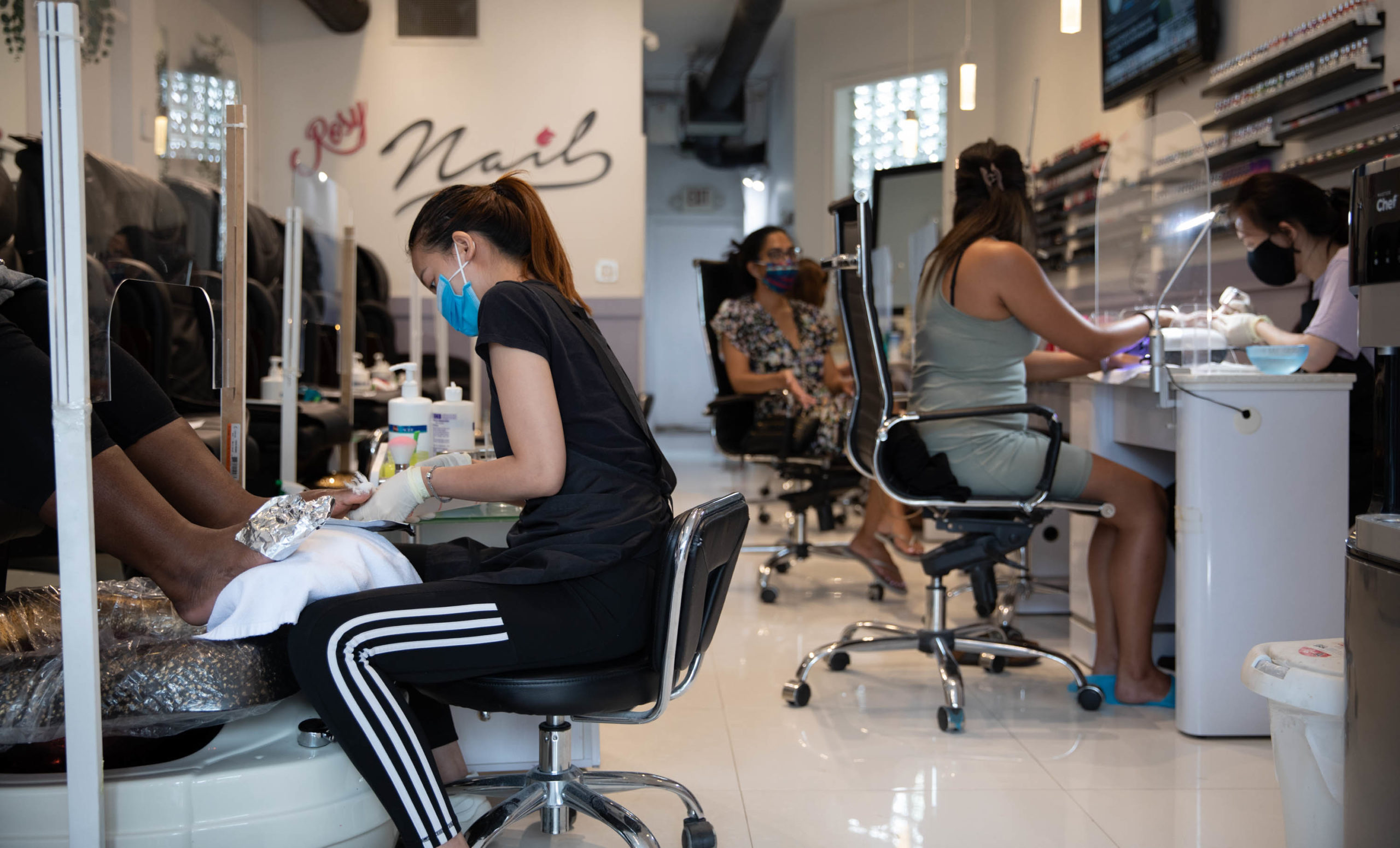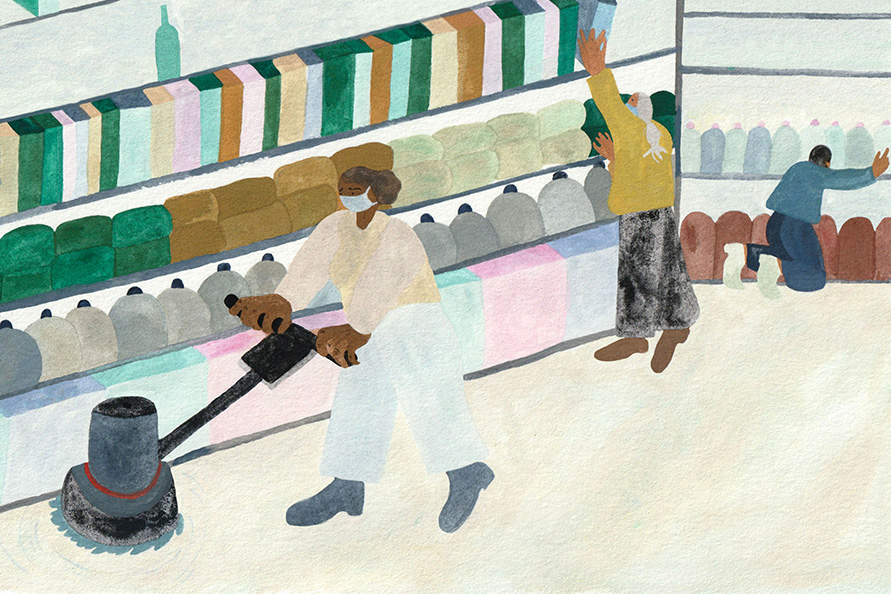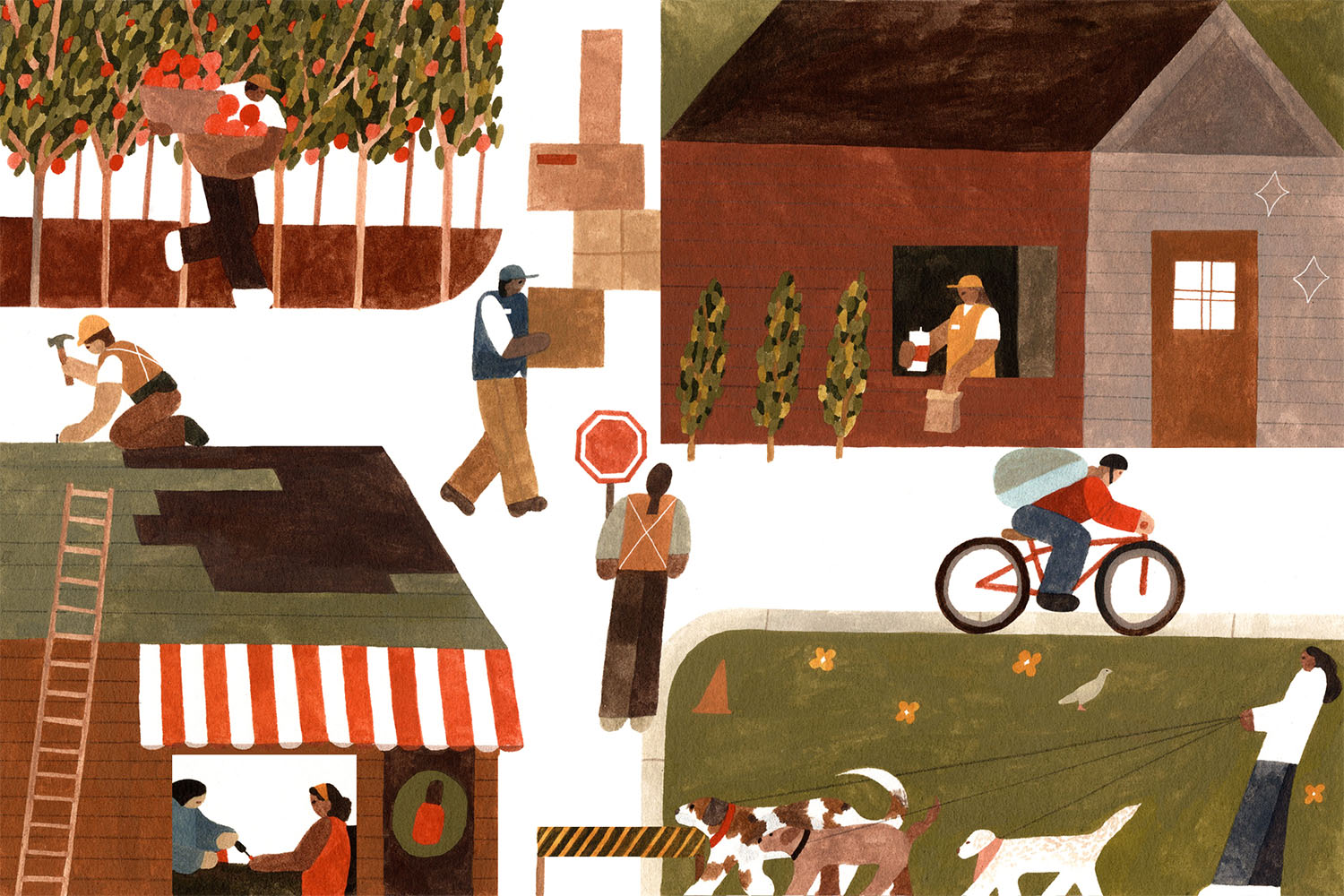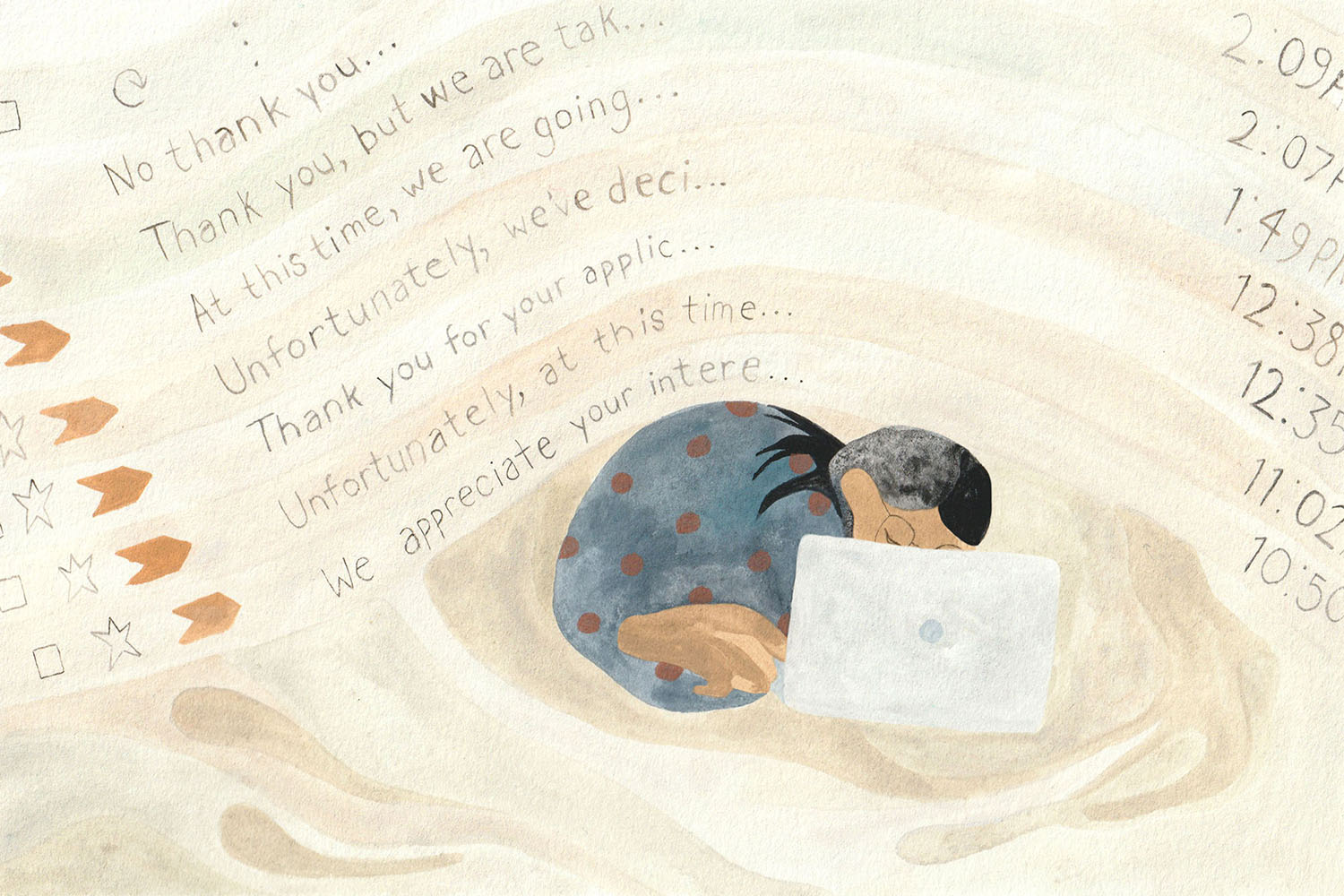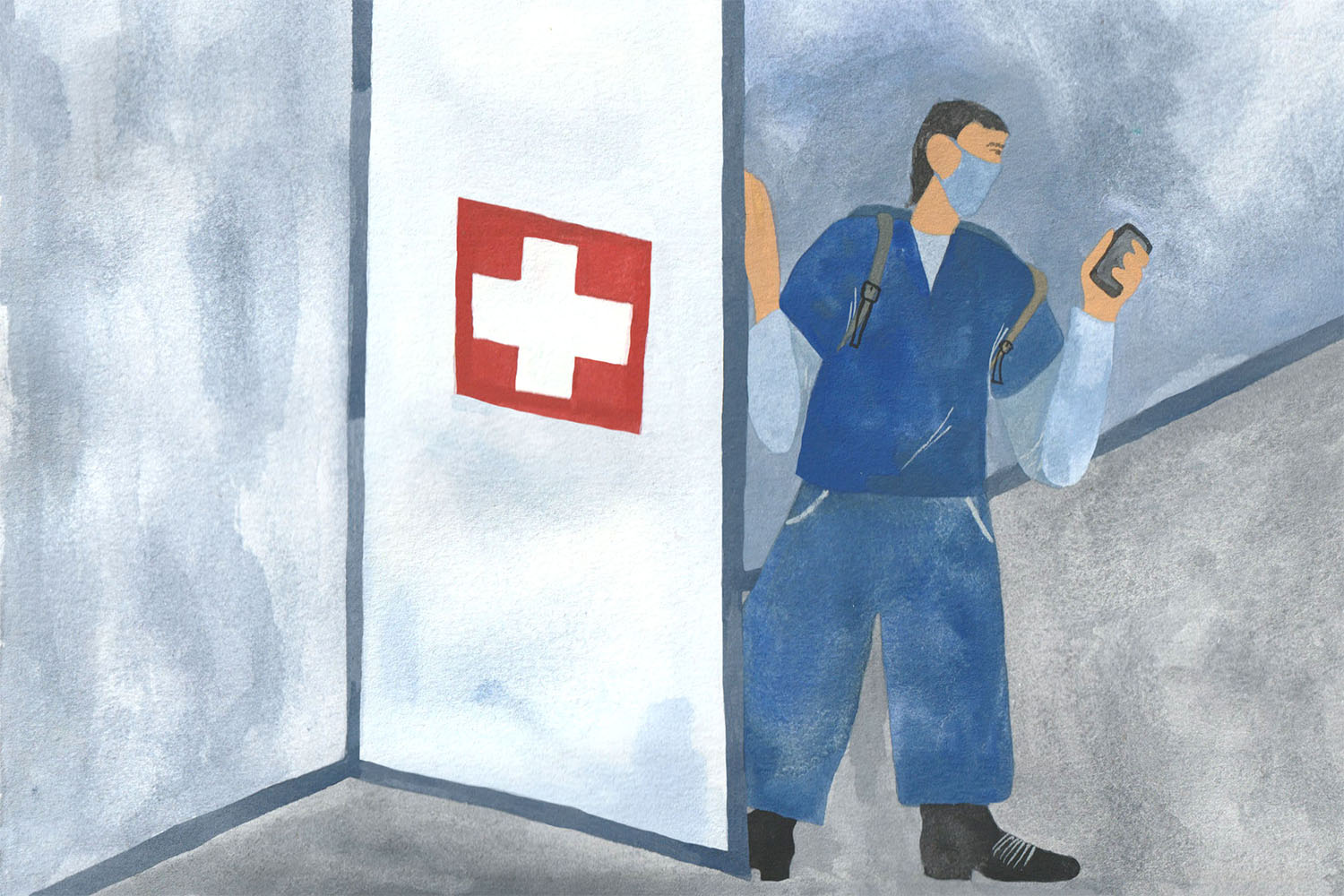
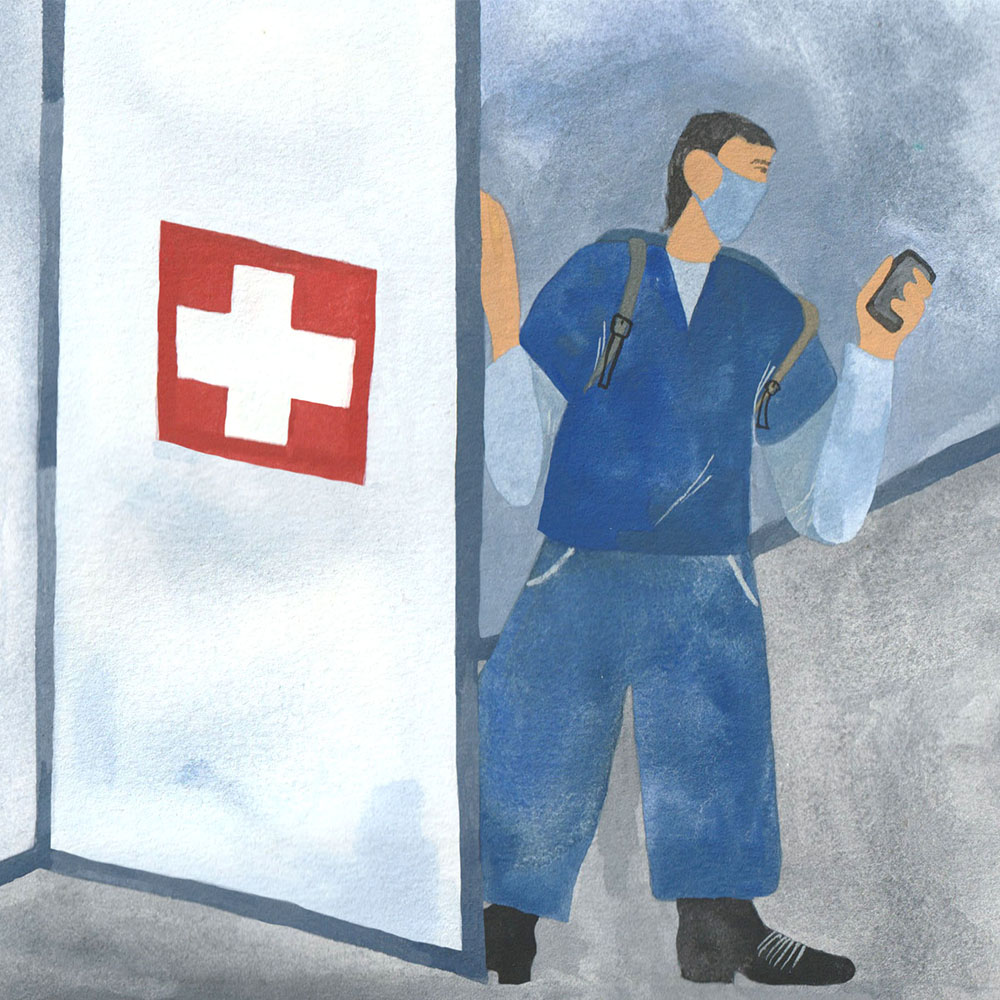
When Teame Kifleyesus Misghinna woke up on the last Saturday in July, he was out of work. At 6:00 a.m., he switched on the notifications for an app on his phone. Ten minutes later, he saw that the Toronto General Hospital was posting five shifts in its emergency department—jobs like keeping an eye on complex patients or helping out nurses. Misghinna applied to all five of them. By 6:20 a.m., he’d been hired for one.
The shift would start just 70 minutes later. He showered, got dressed, packed his lunch, and arrived by bike at the hospital five minutes before start time. He worked 12 hours that day, caring for a patient with mental health issues—watching, assisting, assessing, and documenting—in a position known as a “constant observer.”
Misghinna, age 37, has been picking up shifts this way three or four times a week for the past eight months. Most of his jobs have been as a patient observer or personal care assistant or sign-in person at a vaccine clinic—even though he was a qualified physician back in his native Eritrea, and later in Uganda. He came to Canada in September, 2019, but needs to write qualifying exams and go through a few years of residency before he can practise medicine here. Three or four shifts a week of this on-demand work help pay his bills while he makes his way towards that goal.
The app that he uses is called Staffy, and it connects health care workers with jobs. Download the app and it will ask you for your credentials—education, training, certificates, resume, references—and an HR person with Staffy will review it all, along with police and vulnerable sector checks, and either accept you or decline you. Once vetted and approved, you can create a profile so that hiring organizations can find you, and you can scroll through and apply for posted jobs.
Misghinna likes that it’s fast. “Instantly, you can get the shift or you cannot get the shift,” he says. You know right away whether you’ll be working, or doing something else for the day, like studying. Jessica de Souza, a GTA nurse who also uses Staffy, likes it too. “You don’t have to talk to anybody,” she says. “It’s very versatile and convenient in the palm of your hand.”
Workers can see the specifics of the jobs on offer—the location, the hiring organization, the day and time, the pay. Once they arrive at work, they sign in through the app; GPS on their phones confirms that they’re there. After the work is done, an invoice is automatically generated and they are paid within a few days.
After a shift, the hiring organization rates the worker. They might give a high rating and ask to have the person back. Or they might give a low rating and say it didn’t work out—in which case, the prospective worker won’t be shown job postings from that organization again. Workers can block organizations too.
“It’s actually a brilliant idea,” says de Souza.
Not everyone thinks so, of course. Misghinna and de Souza and lots of other people value the speediness and flexibility that apps like Staffy and BookJane provide. But the vast majority of people working in health care are looking for permanent full-time jobs that offer stability and security, according to the Service Employees International Union (SEIU), which represents workers in hospitals, home care, nursing, and retirement homes.
In contrast, Staffy workers, like Uber drivers, are considered “independent contractors” who work for themselves. That means there is no paid time off, no overtime, no sick days, no pension, no employer CPP contribution, no employer EI contribution, and no tax taken off at source. That’s all up to the worker to figure out.
“All of these are things that we often don’t think we need until we need them,” says Jennifer Scott, president of Gig Workers United. “And then when we need them, we see that we’re in really big trouble.”
Sharon Lee Smith, chief operating officer at Staffy, says that people who find jobs through the app are educated about all that through a quiz they take when they sign up.
From the SEIU’s point of view, that’s not good enough. “Our laws should be written to protect workers from misclassification as so-called independent contractors,” says Sharleen Stewart, president of SEIU Healthcare. The whole purpose of calling these workers independent contractors, she says, is to avoid paying for workers’ benefits—to maximize profits.
Indeed, on August 12, the Ontario Superior Court of Justice certified a class-action lawsuit against Uber, allowing it to proceed with the argument that Uber’s drivers are not independent contractors at all, but rather employees, who deserve minimum wage, vacation pay and other protections. “Uber has complete control over these drivers, when they work, how they work, what they get paid for the work that they do,” Samara Belitzky, a lawyer at Samifiru Tumarkin LLP, the firm that is representing the workers, told the Canadian Press. “Yet the drivers don’t have the benefits and the protection that employees would normally have in situations where the employer is in control.”
Staffy argues it is not an employer—and not looking to replace or fill full-time jobs. “We are a workforce optimization tool that enables workers to pick up extra shifts based on their schedule and lifestyle,” says Lee Smith. “With our platform, organizations can fill critical roles at the last minute, or hard-to-fill roles like weekends, holidays or overnight shifts.” But according to The Toronto Star, last April a labour inspector ruled that Pals Staffing, another business that matches health workers to jobs, had been misclassifying its workers as independent contractors. (Pals is contesting the ruling.) The ministry said that because workers were using the employers’ equipment and did not set their own rates, they were not self-employed.
“An app would rather see us turn around and leave than pay us more”
Staffy started in 2015 as an app serving the hospitality industry. When a line cook or server didn’t show up, Staffy quickly plugged the gap. When the pandemic hit, Staffy was already active in the kitchens of long-term care facilities. Struggling to find enough nurses and personal support workers to deal with the pandemic’s extra demands, the care homes asked Staffy if it could work the same magic with health workers. “That’s where our big pivot came in,” says Lee Smith. From March 2020, Staffy’s health care side was up and running. Since then, it has exploded.
Staffy lists work for all sorts of health care professionals, from dietary aides to personal support workers (PSWs), from registered practical nurses (RPNs) to registered nurses (RNs) with specialist training in intensive care and emergency medicine. Some 10,000 health care workers are now signed on, says Lee Smith, most of them in the province of Ontario.
Misghinna says he was recruited by someone he didn’t know off Indeed.com, a rival job-search platform. At the time, Misghinna had been without work for more than a year. He didn’t know about agencies and none of his Eritrean friends worked in health care. “I was like an island,” he says. “I was isolated from my profession. I was disconnected from any other health workers.” But even though he found it a bit beneath him to work at low-ranking jobs, he was delighted to be back in a hospital setting, which he describes as a “second home.” Not only is he getting Canadian work experience, he says he’s getting medical exam tips, references and valuable connections.
Recruiting workers from other job boards is a common strategy. So is word of mouth. Staffy offers up to $150 for a successful referral, says Lee Smith.
That’s how de Souza found out about it—via a co-worker from an agency. De Souza had returned from a nine-month stint working as a nurse in Australia just as the pandemic’s second wave was hitting Toronto. While working abroad, she’d let her Ontario nursing license lapse, so when she first got back she used Staffy to find a gig as a PSW in a long-term care home in Ancaster. In the new year, after she’d renewed her license, she took another Staffy job, this time as a RPN at a long-term care facility run by Extendicare in Mississauga. That one lasted four months.
“It helped me when I came back from Australia,” she says, “because I had full-time work for six months on end, and I wasn’t struggling finding work.” She says she always felt a part of the team. When she left the PSW job, her colleagues gave her a gift card and told her to come back and visit. “When I worked with Extendicare,” she says, “it almost felt like I was their staff.”
De Souza, age 29, now has a regular part-time nursing job at the Brampton Civic Hospital, but until recently, Staffy’s been filling up her spare time with vaccine clinic jobs—sometimes preloading syringes, sometimes administering the jabs. She’s starting a demanding course in anatomy and physiology this fall, but still intends to pick up the occasional extra shift through the app.
Eram Chhogala, 36, has full-time work as an ER and trauma nurse at Scarborough Health Network and Sunnybrook Health Sciences Centre. She hasn’t taken a shift with Staffy yet, but has signed up. “I may consider it. I might. I mean, I have had a look at it myself. And it was very interesting.” But overall, she worries about things like the pension—that there isn’t one.
That’s important, says Scott, of Gig Workers United, which represents a lot of couriers. “We have members who can’t retire, who are still out on the road riding bicycles and delivering things into their seventies.”
Unlike in the courier and delivery industry, where wages are low and going down, health care workers, during the pandemic at least, are getting competitive rates. Staffy takes a cut—a “transaction fee” that starts at 25 percent, says Lee Smith—from the hiring side. Even so, the pay they typically offer is attractive, sometimes almost double what you’d get directly from an organization. Ordinarily, a newly-minted registered nurse might start at around $22 an hour, according to the Registered Nurses Association of Canada (RNAO). Through Staffy, nurses can often get around $40, and sometimes more.
Doris Grinspun, CEO of the Registered Nurses’ Association of Ontario, doesn’t begrudge nurses trying to earn as much as they can, but she worries about the effects of what are effectively bidding wars over nurses. Hospitals desperate for nursing staff will post a wage, then keep raising it as the start time draws near. They start at $60 an hour, she says. An hour later, they are offering $80, applying the logic of Uber’s surge pricing to nursing care. Wait long enough and it will be $100 an hour, says Grinspun. This is driven by short-term demand and shows a lack of proper planning, she says. “It destabilizes the profession,” says Grinspun.
For his part, Misghinna has always been able to rustle up enough shifts to fit his schedule. But he knows some workers who complain about a shortage. There are a lot of workers, he explains, and a finite number of jobs. “You don’t have any guarantee. If I work today, tomorrow I don’t have any guarantee whether I’m going to continue the same shift or in the same hospital,” he says.
Scott warns that the gig model is based on workers being dispensable. “An app would rather see us turn around and leave than pay us more,” she says. “They’d rather just constantly onboard from a pool of unknown people—new workers who will work for less and less and less.”
Independent contractor status can also cause problems for students needing to demonstrate work experience. Rohit Godiwal is an RPN about to start training as an RN. In order to qualify for school, he needs to have proof—on employer letterhead—of 1700 hours of work experience. The problem is that 900 of his hours were through Staffy, and no one wants to provide the official letter: both the hiring organization and Staffy insist they’re not his employer.
Godiwal says he can’t even get Staffy to communicate by phone—just text.
“They were really good at providing shifts, and I was doing hour after hour, overtime after overtime. This is a bummer if this can’t be accepted,” says Godiwal. “I will be really, really screwed.”
Get used to it, says Scott. One of the most important things you lose when you’re misclassified, she says, is an accessible path to recourse, and to justice.




